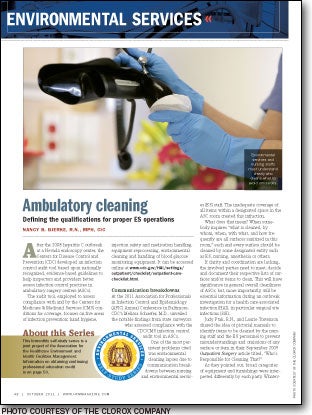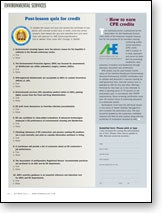Ambulatory cleaning

After the 2008 hepatitis C outbreak at a Nevada endoscopy center, the Centers for Disease Control and Prevention (CDC) developed an infection control audit tool based upon nationally recognized, evidence-based guidelines to help inspectors and providers better assess infection control practices in ambulatory surgery centers (ASCs).
The audit tool, employed to assess compliance with and by the Centers for Medicare & Medicaid Services (CMS) conditions for coverage, focuses on five areas of infection prevention: hand hygiene, injection safety and medication handling, equipment reprocessing, environmental cleaning and handling of blood glucose monitoring equipment. It can be accessed online here.
Communication breakdowns
At the 2011 Association for Professionals in Infection Control and Epidemiology (APIC) Annual Conference in Baltimore, CDC's Melissa Schaefer, M.D., unveiled the notable findings from state surveyors who assessed compliance with the CDC/CMS infection control audit tool in ASCs.
One of the most persistent problems cited was environmental cleaning lapses due to communication breakdowns between nursing and environmental services (ES) staff. The inadequate coverage of all items within a designated space in the ASC room created this infraction.
What does that mean? When somebody inquires "what is cleaned, by whom, when, with what, and how frequently are all surfaces sanitized in this room," each and every surface should be cleaned by some designated entity such as ES, nursing, anesthesia or others.
If clarity and coordination are lacking, the involved parties need to meet, decide and document their respective lists of surfaces and/or items to clean. This will have significance in general overall cleanliness of ASCs; but, more importantly, will be essential information during an outbreak investigation for a health care-associated infection (HAI), in particular surgical site infections (SSI).
Judy Ptak, R.N., and Laurie Tostenson shared the idea of pictorial manuals to identify items to be cleaned by the nursing staff and the ES personnel to prevent misunderstandings and omissions of any surface or item in their September 2009 Outpatient Surgery article titled, "Who's Responsible for Cleaning That?"
As they pointed out, broad categories of equipment and furnishings were interpreted differently by each party. Whatever approach works for ASCs should be employed to ensure clarity of responsibilities. Written policies and procedures on environmental cleaning can be used as checklists for measuring compliance within ASCs.
All this focus on environmental cleaning means that the ES team's role in infection prevention and control remains as it has been promoted — as front-line infection preventionists (IPs). They are where the action is. They witness the environmental infractions, perform the expected sanitation and disinfection practices to reduce reservoirs for potential microbial proliferation, promote safety by their interventions that maintain a clean environment and decrease occupational exposures with proper use of chemical agents as they interface with the patients which, in turn, affects the facility's patient satisfaction scores.
Whether in an acute care hospital, long-term care facility or ASC, ES professionals view themselves as impacting patient care by performing their responsibilities to the best of their abilities with the resources at hand.
Health care recognizes the value of ES and spotlights its value because of its due diligence in keeping the environment clean and safe — especially with the ongoing strategies to contain, confine, and combat multidrug-resistant organisms (MDROs). These pathogens include methicillin-resistant Staphylococcus aureus (MRSA), vancomycin-resistant enterococci (VRE) and multidrug-resistant Acinetobacter baumannii. Added to these MDRO pathogens is the complex Clostridium difficile and its persistent spores. All of these pathogens are challenges to the patient, health care facility, IPs and ES department.
ASCs not exempt
ASCs are not exempt from the focus of assessment entities, which are expanding their scope to include ASCs. Thus, increasing emphasis is directed at ASCs and their adherence to established guidance for patient care in an ASC. The results may well affect their reimbursement stream as ASC patients are as diverse as those admitted to the hospitals for care.
The ASC previously was viewed as the place healthy patients entered for minor invasive procedures. While ASCs handle a large volume of short-term patients seeking care, these minor operations have advanced to more complex and involve some patients with more serious comorbidities.
The role of ES remains the same; but resources to ensure adequate coverage of all areas and case turnovers have not always met the demands as well as they should. ES has resorted to a business case approach to convince the chief executive officer that additional resources are necessary to maintain the expected level of performance.
Within this business case, aspects should also enumerate how ES will further support infection prevention and patient care with improved cleaning technology. New tactics have evolved in the form of products (e.g., Environmental Protection Agency-registered environmental disinfectants and microfiber) and equipment (e.g., ultraviolet light, hydrogen peroxide and adenosine triphosphate bioluminescence) to interrupt the chain of transmission in reservoirs and vehicles of transmission.
These are being evaluated within ASCs as appropriate, effective, efficient, safe and value-added. The evaluation process gathers the expertise of IPs, ES, administration and professional staff to objectively weigh the advantages and disadvantages of these items and arrive at a decision to invest in enhanced outcomes in patient care and safety.
The personnel factor
People are required to use the products and equipment effectively within ASCs. Whether an ES contractor is employed to service the ASC or the ASC hires its own employees to work as ES personnel, specific capabilities are essential to quality, value and safety when delivering patient care.
Job description attributes, personnel competencies, performance evaluation criteria, fiscal responsibilities and compliance with established performance standards (to name a few) lend themselves to objective assessment in selecting ES personnel.
Documented training, consistent performance, ample ES personnel for the ASC's demands, and excellent references from other health care facilities are some of the background information worth reviewing before making an informed decision.
Another element that speaks to professionalism is certification of the ES director and professional membership in the Association for the Healthcare Environment (AHE). Knowledge of, use of and compliance with the AHE Practice Guidance for Healthcare Environmental Cleaning (https://www.associationstores.org:443/OA_HTML/ibeCCtpSctDspRte.jsp?section=10160); the current edition of the Association of periOperative Registered Nurses' (AORN) Perioperative Standards and Recommended Practices (www.aorn.org/PracticeResources/AORNStandardsAndRecommendedPractices/); the Centers for Disease Control and Prevention's Guideline for Disinfection and Sterilization in Healthcare Facilities (www.cdc.gov/hicpac/pubs.html); and state requirements for ES are essential to achieving performance expectations within ASCs.
Orientation and ongoing monthly in-service training reinforce the basic principles, policies and procedures of ES. These and others specific to the institution are integral to the decision of hiring an ES business or ES personnel to service the ASC.
Requesting and checking the references supplied by the ES contractor or persons seeking employment at ASCs involve phone calls, emails and networking. Also, courthouses have records of legal names of contractors and the Better Business Bureau will have responses by customers of the ES contractor. Some institutions have a standard form with specific objective questions that are used when doing reference checks. This ensures that, as a minimum, each reference is asked the same questions.
Other avenues include knowing individuals who work in the same institutions named by the contractor or job applicant: What is their personal impression of the contractor or person? What does the environment look like after ES performance? Was there any noteworthy or pertinent information that an employer would appreciate knowing before hiring?
Additional information to consider is the CDC/CMS audit tool to assess infection control practices in ASCs. The four CDC/CMS infection prevention and control audit tool statements are simple and direct. They are:
- Operating rooms are cleaned and disinfected after each surgical or invasive procedure with an EPA-registered disinfectant.
- Operating rooms are terminally cleaned daily.
- High-touch surfaces in patient care areas are cleaned and disinfected with an EPA-registered disinfectant.
- The ASC has a procedure in place to decontaminate gross spills of blood.
- Additional breaches in environmental cleaning not captured by the questions above were identified.
(The scoring of these statements is determined by answering "Yes," "No" or "N/A" to the question, "Was the practice performed?"; and, for the "Manner of confirmation," by answering "Observation," "Interview" or "Both.")
Because ES is being considered by numerous assessment entities (i.e., CMS, state authorities and the Joint Commission), it is vital that these scores from previous employers also be reviewed when hiring an ES contractor or individual.
The mindset within the ASC and its administration can remain cutting-edge. By being proactive, ASCs could internalize assessment tools and resultant scores to enhance their patient outcomes. Awareness of emphasis areas, consequences of negative scores, wise investments in resources and ongoing communication will advance the ASC, particularly as it views and supports ES as a vital department to achieve patient satisfaction and outcomes.
Front-line preventionists
ES professionals are the front-line infection preventionists in ASCs and must be judged by the highest standards when hired or outsourced.
ES professionals are encouraged to explore the documents referenced in this article to learn more about the role of ES in ASCs.
Nancy B. Bjerke, R.N., MPH, CIC, is infection control consultant at Infection Control Associates, San Antonio. She can be contacted at nancy@icabjerke.net.
About this seriesThis bimonthly self-study series is a joint project of the Association for the Healthcare Environment and Health Facilities Management. Information on obtaining continuing professional education credit can be found here. |  |
| Click above image for quiz. |


